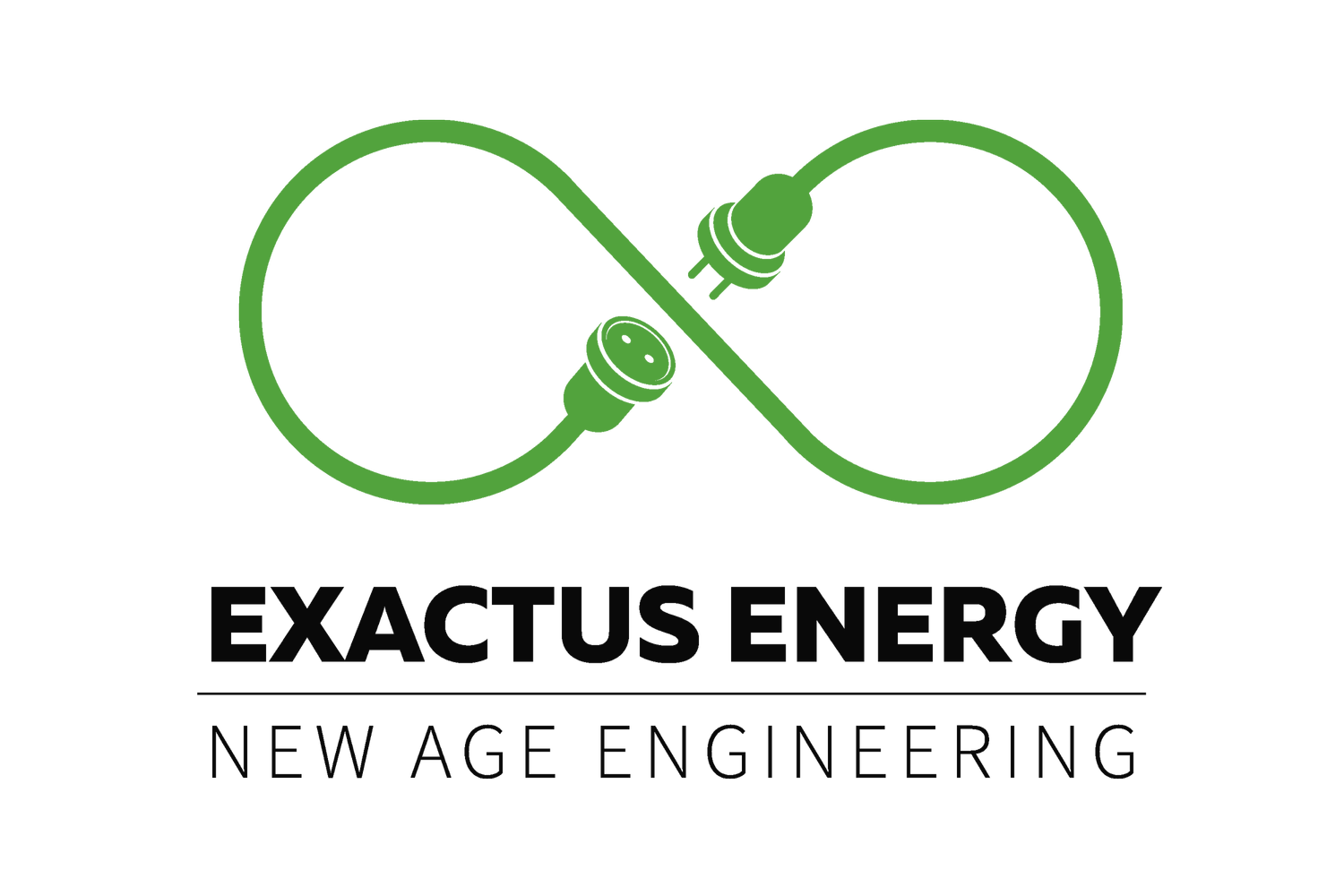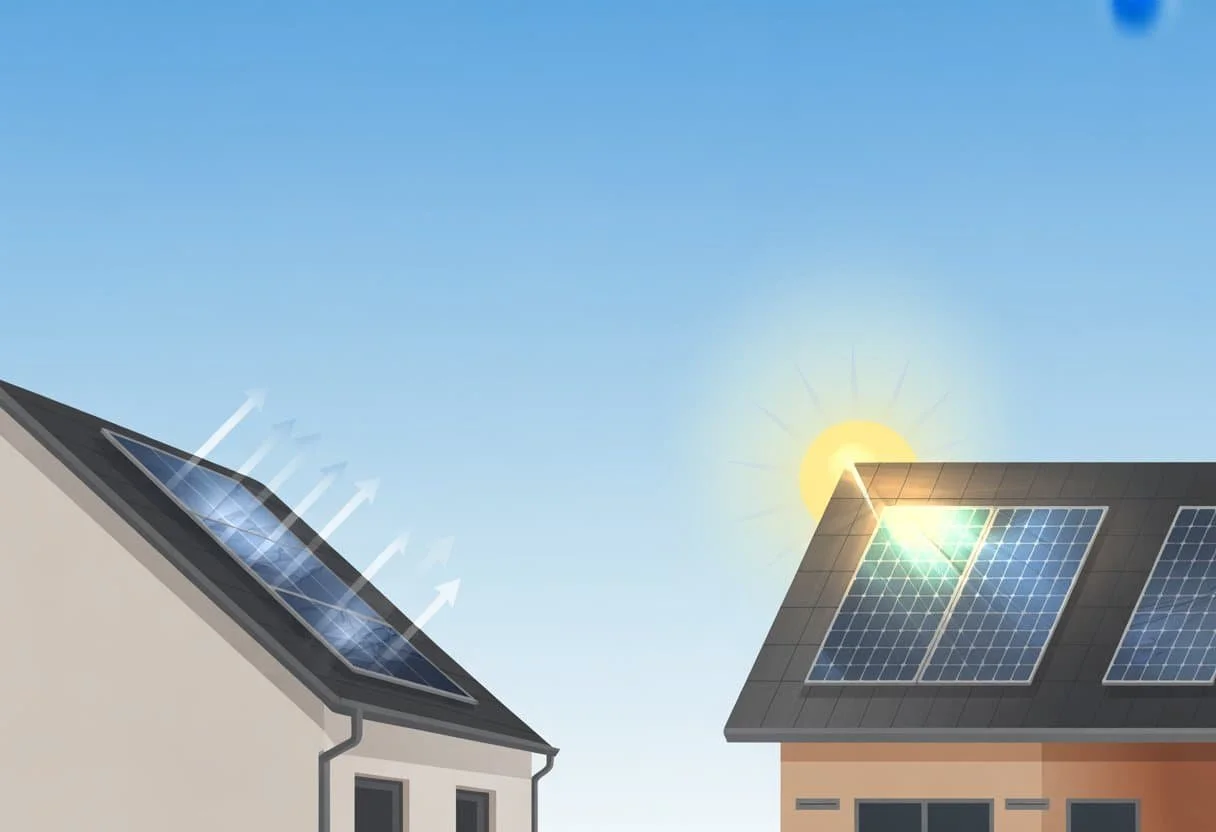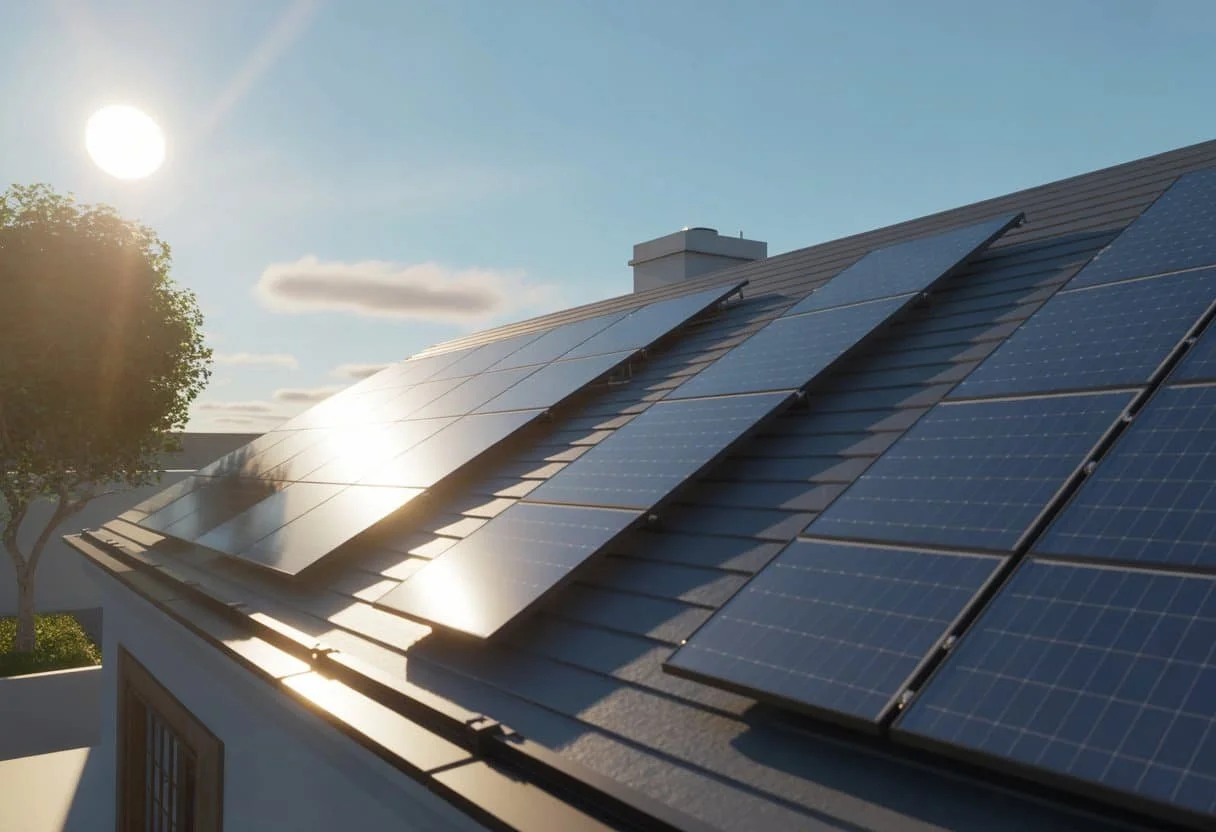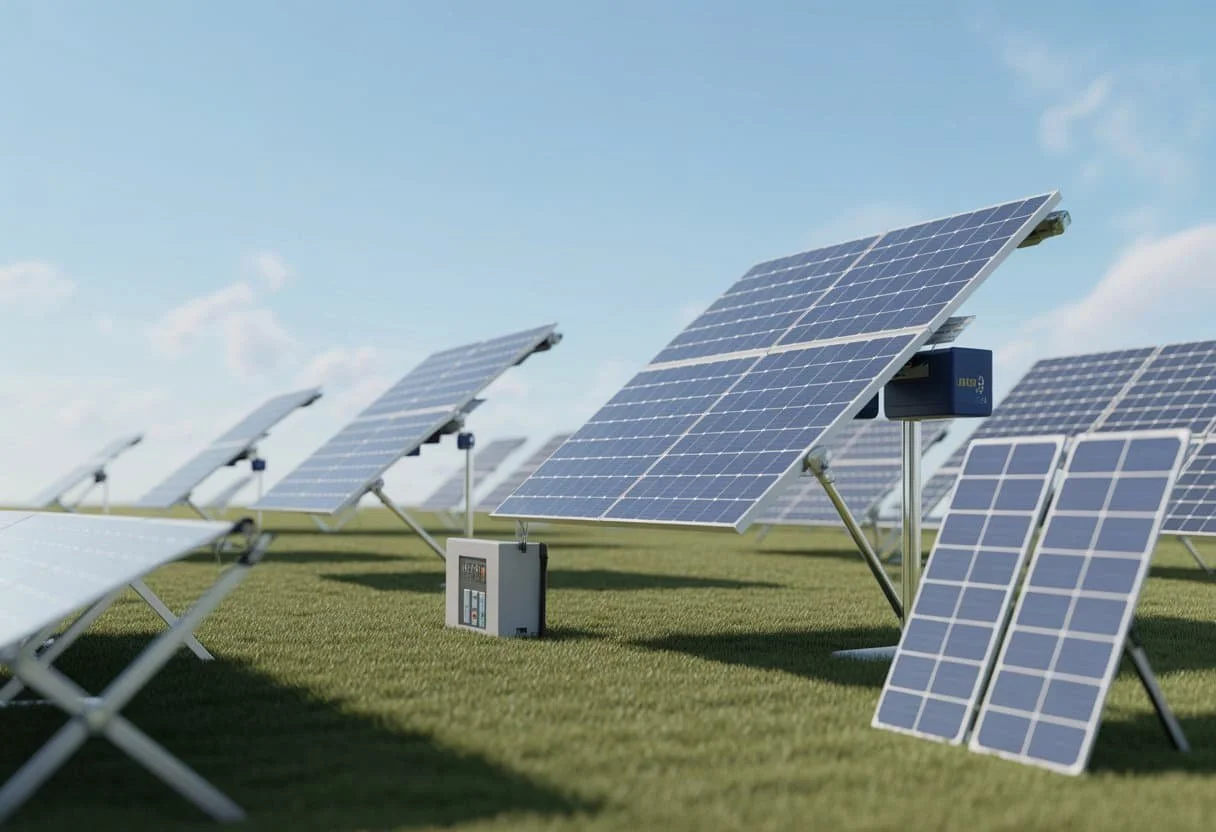It may seem like a small thing to get the angle right for your solar panels, but it can have a big effect on how much energy they produce. To get the most sunlight all year round, most homes in Canada need solar panels that are tilted 30 to 45 degrees. In the summer, the best angle for your solar panels is your latitude minus 15 degrees. In the winter, the best angle is your latitude plus 15 degrees.
You need to plan carefully before putting up solar panels to make sure you get the most out of your money. In the northern hemisphere, a south-facing orientation usually works best, but southeast and southwest can also work. Some homeowners choose fixed-angle systems that keep production steady all year, while others choose adjustable mounts that let them optimize production for each season.
Community solar projects all over Canada show how important it is to angle things correctly to get the most energy. Professional installers use solar power system designs that are specific to your site and take into account things like your location, roof pitch, shading problems, and local weather patterns. All of these things together will help you find the best setup for your needs.
Why the best angle for solar panels affects how much solar energy it produces
The angle of the solar panel has a direct effect on how much sunlight it can collect. Panels get the most energy when sunlight hits them at a perfect 90-degree angle. Panels that are tilted toward the sun can make up to 40% more power than panels that are not well angled.
The sun moves around during the day and the seasons. In the winter, the sun is lower in Toronto, and in the summer, it is higher. To get the most energy out of a panel all year round, its tilt angle must take these changes into account.
The angle of the panel has an effect on three important things:
- Direct exposure: Panels that are angled correctly get more direct sunlight.
- Light reflection: The best angles make it so that sunlight doesn't bounce off of panel surfaces as much.
- Seasonal performance: The right tilt keeps summer and winter production in balance.
A 5° change from the best tilt angle can cut energy output by 3% to 5% each year. This is hundreds of kilowatt-hours a year for a typical 8kW home system.
Solar engineers use latitude to figure out the best angle. In Canada, the best tilt angle for fixed mounts is often the same as the latitude of the area. Toronto is about 43° north of the equator, which is a good place to start.
The best place to put the panels also depends on the weather. Steeper angles (latitude +10–15°) help areas with snowy winters get rid of snow and catch low winter sunlight.
A lot of homeowners now pick adjustable mounting systems. These let you change the angle of the roof to get the most sunlight all year round.
Tilt Based on Latitude: The Proven Starting Point
Your location is the most important factor in finding the best way to place solar panels. Your latitude is what determines the best angle for your panels.
This number becomes your baseline angle for homes and businesses in Toronto (latitude 43.7°). This simple method makes sure that energy is produced all year round without needing to be changed for the seasons.
The latitude rule works because:
- It is about the same as the sun's average position in the sky.
- It works well all year round.
- It's simple to use with fixed mounting systems.
Your location doesn't just affect the temperature; it also affects how high the sun moves across your sky all year long.
Changes for the seasons:
| Recommended Tilt for Each Season | Toronto |
|---|---|
| Fixed all year long | 43.7° latitude |
| Summer optimization | 15° latitude, 28.7° longitude |
| Winter optimization | 15° north and 58.7° south |
These changes can increase production by 5% to 15% during the season. Summer angles help with longer days and more sunlight, while winter angles help with shorter days and lower sun paths.
When customers don't want adjustable mounts, many installers just use the latitude of the location as the default angle. This method gets about 90% of the most energy possible each year.
Keep in mind that these latitude-based rules are just suggestions. To get the best results, you may need to make small changes based on things like nearby buildings or trees.
Optimal angle of the roof vs. the best angle
Most houses weren't made to have solar panels on them. The angle of your roof right now might not be the best one for getting the most solar energy in your area.
For solar panels in Toronto and the surrounding areas, the best angle is usually between 30 and 40 degrees. At our latitude, this angle gets the most energy year-round.
This angle may not be the best for your roof pitch. The pitch of a typical Canadian residential roof is between 18 and 22 degrees (4:12 to 5:12 slope), which is not the best angle for collecting solar energy.
There are two main ways to install it:
-
Flush mounting means putting panels on top of your current roof surface.
- Easier to put together
- Less expensive
- More pleasing to the eye
- 5–15% less effective than the best angle
-
Tilted mounting - Panels are put on racks at the best angle.
- Most energy production
- More expensive to install
- Easier to see from the ground
- More things to think about when it comes to wind resistance
The direction of the roof is also important. In the northern hemisphere, roofs that face south get the most sun. Orientations to the east and west can still work, but they make about 15–20% less energy.
Most of the time, the choice comes down to what works best. Most installations use the same roof design as before for ease of use and looks, even though it means a small loss in efficiency.
A 5–10 degree difference from the best tilt usually only lowers annual production by 1–3%, which is often not enough to make tilt racking worth the extra cost.
Not Always Best to Face South
Most solar experts say that panels that face south will produce the most energy in Canada each year. This direction, with an azimuth angle of 180° (true south), usually gets the most sunlight all year long.
But south isn't always the best choice for everyone. It's more important to think about your own needs and situation than to follow general rules.
During times of high electricity prices in the afternoon, panels that face west (azimuth around 270°) often work better than those that face south. If your utility charges time-of-use rates, this orientation could save you money.
How direction affects solar production:
- South (180° azimuth): Most total production each year
- Southwest (225° azimuth): A good balance between total output and afternoon output
- West (270° azimuth): Lower total yield but higher afternoon generation
- East (90° azimuth): Peak production in the morning, which is good for morning electricity needs
An east-west split arrangement makes sure that electricity is made all day long on flat or low-slope roofs. This arrangement has panels facing both ways, which makes the power output more stable.
The best way to set up solar panels depends on how much electricity you use, how much your local utility charges, and how your roof is set up. A 30° tilt to the south isn't the best option for all Canadian homes.
The best direction for your panels also depends on where you live. Some properties in northern Canada might do better with panels that lean slightly west to help with fog or other weather conditions in the morning.
Seasonal adjustments for maximum output with optimal solar panel angles
Changing the angles of solar panels during the year can greatly boost energy production. Panels that move with the sun's path throughout the year get more sunlight than those that stay in one place.
Most experts in solar energy say that you should change the tilt of your panels 2 to 4 times a year. This frequency gives you the best balance between how much work you have to do to keep it up and how much energy you get back.
The best seasonal changes look like this:
| Recommended Tilt for Each Season | Sun Position |
|---|---|
| Summer | 15° south of the equator; high in the sky |
| Fall/Spring | Same as latitude; Mid-position |
| Winter | 15° south of the equator; low in the sky |
This means that for Toronto's latitude (43.7°), the best settings for summer are around 29°, for spring and fall are 44°, and for winter are 59°.
Compared to fixed installations, these changes can increase yearly production by 5% to 12%. The best benefits happen in the winter when there isn't much sunlight.
Many homeowners think that making changes every three months (once every season) gives them the best return on their money. Changes that happen more often give less and less value while needing more work.
Fixed systems also work very well. Setting panels at latitude minus 5° gives good performance all year round if adjustments aren't possible.
Newer tracking systems can automatically change tilt throughout the year, but they cost more at first. For most home installations, making seasonal changes by hand is a better deal.
During the winter, make sure to clear away any snow that has built up. This has a bigger effect on performance than the angle of tilt when it snows heavily.
Ground mounts and portable panels with fixed tilt give you more options
With ground-mounted solar systems, you can move the panels around however you want. These setups let owners change both the tilt angle and the orientation without worrying about building codes, unlike roof installations.
For big properties, ground mounts can be put in the places that get the most sun. This flexibility often leads to 15–25% more energy being produced than with fixed roof systems.
The best uses are:
- Cottages and cabins in the woods
- Setting up an RV or camping site
- Properties with roofs that aren't right
- Places that need to have their angles changed every season
Portable panels give you even more options. You can move these light options around during the day to follow the sun's path.
A lot of ground-mounted systems have racks that can be changed. These let you change the angle of the panels seasonally to get the most out of the sun's changing position throughout the year.
! [Ground mount setup with racking that can be moved]
Toronto's seasonal angle suggestions are:
| Best Tilt Angle for Each Season |
|---|
| 30° in the summer |
| 45° in the spring and fall |
| 60° in the winter |
It's easy to make changes with specialized angle stands and tilt guides. Most portable systems come with built-in supports that lock at certain angles to make setup quick.
The main trade-off? Installing systems on the ground takes up more space and materials than installing them on the roof. But because they are easy to get to, it is much easier to keep up with and clear snow during Canadian winters.
Is tracking a good idea for home use?
Solar tracking systems can greatly boost energy production by following the sun's path during the day. Single-axis trackers only move on one axis, while dual-axis trackers move both horizontally and vertically to get the most exposure.
For most homeowners, fixed solar panels are still the best option. It costs an extra $5,000 to $10,000 to install tracking systems, and the moving parts need to be serviced on a regular basis.
For most homes, the math doesn't work out in favor of trackers. They can increase energy production by 25–40%, but the extra costs usually make the payback periods longer than most homeowners would like.
Important things to think about:
- Space on the roof that is available
- Rates for electricity in your area
- Patterns of sunlight in different areas
- Limitations on the budget
- Willingness to do maintenance
For ground-mounted systems where there is enough room, solar trackers make more sense. People who own large homes and need a lot of energy might find the investment worth it.
| Type of System | Cost Premium | Output Gain | Maintenance | Best For |
|---|---|---|---|---|
| Fixed | $0 | Baseline | Minimal | Most homes |
| Single-axis | $5,000 more | 25% more | Moderate | Large properties |
| Dual-axis | $10,000 more | 40% more | High | Premium installations |
Tracking systems may be helpful for high-end homes that use a lot of energy and have enough space. Over time, the higher efficiency can make up for the higher initial costs.
For most home uses, buying more fixed panels usually gives you a better return than putting fewer panels on tracking systems.
Tools for figuring out the optimum angle
You don't have to guess what the best tilt angle is for solar panels. There are a number of dependable tools that can help homeowners and installers find the best angles for getting the most energy out of their systems.
The National Renewable Energy Laboratory made the PVWatts Calculator, which is a free online tool. It figures out how much energy will be made based on where you are, the type of panels you have, and the angle of the panels. You can compare possible energy outputs by just entering your postal code and changing the tilt settings.
Solar panel tilt angle calculators give you quick answers without needing to enter a lot of information. Some popular choices are:
- Calculator for the EcoFlow Solar Angle
- Shop for solar kits and an angle calculator
- SunCalc.org
These tools take into account where you live and how the seasons change to suggest the best fixed angle or adjustable schedule.
With real-time capabilities, mobile apps have changed the way solar installations work. Some newer apps use:
- Sensors in the phone that measure the pitch of the roof
- Using GPS data to find exact location
- Tracking the sun's position in real time
For Canadians who have to deal with snow buildup, special calculators take into account steeper winter angles to help the snow melt faster.
Professional solar designers often use more advanced software that takes into account a number of factors:
| Type of Tool | Best For | Level of Accuracy |
|---|---|---|
| Online Calculators | DIY Homeowners | Good |
| Mobile Apps | Installers | Better |
| Professional Software | Engineers | Best |
Most tools let you look at yearly energy production from different angles, which can help you make smart choices about where to put things.
Solar climate and snow considerations with angles
The best angle for solar panels depends on the weather. In places where it snows a lot, steeper angles (40–60°) help the snow slide off on its own. This self-cleaning feature keeps the power from going out in the winter.
Panels that are covered in snow don't make much, if any, electricity. A thin layer can cut output by 30%. When you tilt it the right way, gravity helps you get rid of snow.
Suggestions for the climate in your area:
| Climate Type | Angle Suggested | Benefits |
|---|---|---|
| Snowy | Steeper (40-60°) | Snow shedding, improved winter production |
| Hot | Flatter (10-15°) | Less heat buildup, better efficiency |
| Moderate | Standard (latitude ±15°) | Balanced year-round production |
In cold climates, solar panels work better because they work better when it's cooler. In the winter, an array that is angled correctly can do better than expected.
In the winter, when the sun is lower in the sky, worries about shading grow. Put the panels in places where winter shadows won't block the sun. In the winter, trees that don't shade panels in the summer might do so.
Adjustable mounting systems work best in places where summers are hot and winters are snowy. These let you change the angle of the sun throughout the year, which increases production.
The local microclimate is also important. Coastal regions encounter distinct conditions compared to inland areas situated at the same latitude. For exact angle suggestions, check local solar data.
A Quick Reference Guide
To get the most power out of solar panels, you need to set them at the right angle. This guide gives a quick look at the best angles for different types of installations.
The angle at which solar panels are tilted has a direct effect on how much energy they produce. The general rule is to match your latitude, but there are a few things that can change this.
Things that affect the best angle:
- Latitude in the world
- Changes in the seasons
- Weather in the area
- Different ways to mount it
This is a simple guide to the best angles for solar panels:
| Location Type | Ideal Tilt | type of mount | Notes |
|---|---|---|---|
| Home Roof (Fixed) | Roof pitch or ~Latitude | Flush or tilted | Works well for most homes |
| Ground Mount | Latitude, seasonally adjustable | Adjustable racks | Higher yield with tuning |
| Setup that can be moved around | Adjustable | Tilt guides | Change it once a week for the best results |
| In a snowy area | Latitude + 15° | Tilted or ground | Helps snow slide off |
When setting up something permanently, start with the latitude of your location. The latitude of Toronto is about 43.7°, which makes this a good starting point for the tilt.
Adjusting for the seasons can increase production: in the summer, tilt to latitude minus 15° and in the winter, tilt to latitude plus 15°. This lets you capture the most sunlight as the sun moves around.
Most home installations use fixed mounts that are a good balance between cost and performance. Adjustable mounts work better, but you need to keep them up and make changes to them regularly.
In conclusion, aligning panels with performance goals
It's not just math that helps you find the right angle for solar panels; it's also about matching your energy needs. The right tilt takes into account your location, the space you have, and your power goals.
For most home installations, angles that are equal to the latitude of your location work best. This means a tilt of about 43° in Toronto for year-round performance.
To get the best results in the winter, add 15° to your latitude. A latitude minus 15° approach works best for systems that are focused on summer. Compared to fixed installations, these seasonal changes can make things 5–8% more efficient.
Keep in mind that systems mounted on roofs may not always get the right angles. That's fine! Even angles that aren't quite perfect usually get 85 to 95 percent of the energy that is possible.
Here is a quick guide to the best panel angles in major Canadian cities:
| City | Year-round | Winter Focus | Summer Focus |
|---|---|---|---|
| Toronto | 43° | 58° | 28° |
| Vancouver | 49° | 64° | 34° |
| Montreal | 45° | 60° | 30° |
| Calgary | 51° | 66° | 36° |
Maintenance is also important for long-term performance. Steeper angles are better for getting rid of snow, which might be something to think about in places that get a lot of snow.
Your top priorities—maximum annual production, winter performance, or summer output—should guide your final choice. Depending on your energy needs and the rates charged by your local utility, each has its pros and cons.
Questions that are often asked
The angles of solar panels are very important for making energy. Here are some answers to common questions about how to find the right tilt for your installation.
What is the optimal angle to tilt solar panels to get the most power out of them?
Your latitude is the best angle for tilting. A 43.7° tilt is best for Toronto, which is 43.7° north, because it maximizes annual production.
If adjustable mounts are used, many installers add 10 to 15 degrees in the winter and take away 10 to 15 degrees in the summer.
The latitude angle is often used as a year-round compromise for fixed installations so that they can always produce energy.
What effect does latitude have on the angle at which solar panels should be put up?
The best tilt angle is directly related to latitude. Installations need to be flatter in places closer to the equator and steeper in places farther north.
Panels in northern Canada may need to be tilted 60°, but installations in southern Ontario usually use 40-45° angles.
At higher latitudes, the sun moves around more during the year, so it's more important to make seasonal changes.
What tools can help you figure out the best angle for solar panels in a certain area?
Natural Resources Canada's RETScreen and PVWatts are two examples of online solar calculators that give angle suggestions based on where you live.
Solar pathfinder tools help you figure out if shading problems might affect your ideal angle choice.
Professional solar design software like Helioscope or PVsyst can figure out the exact angles you need to use based on the weather and the roof's shape.
How do changes in the seasons affect the adjustments that need to be made to the angles of solar panels?
In the summer, when the sun is higher in the sky, the angle needs to be less steep (latitude minus 15°).
To get the lower sun path in winter, you need to tilt the camera more (latitude plus 15°).
Seasonal adjustments can boost energy output by 25–35% compared to fixed installations, but they need either manual changes or automated tracking systems.
How much does the direction of a roof affect where and how solar panels are placed?
In Canada, roofs that face south are best because they let panels get the most sunlight all day.
Roofs that face east or west make about 15 to 20 percent less energy, but they can still work if the angle is right.
The pitch of the roof has a direct impact on the cost of installation. Steep roofs that are already at the right angle need fewer mounting materials and labor.
What do shading and other environmental factors mean for where solar panels should be placed?
Even a little bit of shading can cut panel output by 25–40%, so it's very important to position them correctly so that trees, chimneys, or nearby buildings don't cast shadows on them.
In areas with a lot of snow, steeper angles (50–60°) may be needed to encourage natural shedding.
Local microclimate factors, such as fog patterns or nearby reflective surfaces, may necessitate minor angle adjustments from standard recommendations.






